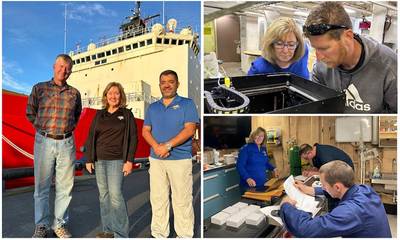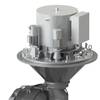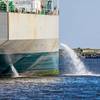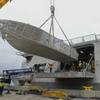NPS Research on Coast Guard Icebreaker to Enhance Arctic Readiness
During a seven-week Arctic transit aboard the U.S. Coast Guard icebreaker USCGC Healy (WAGB 20), researchers from the Naval Postgraduate School (NPS) will study the impact of the extreme environment on crew performance and potential mitigations, as well as advanced Additive Manufacturing (AM) technologies in adverse sea conditions.
The studies, which commenced with Healy’s departure from Kodiak, Alaska on Aug. 26, will be led by principal investigator Dr. Nita Shattuck, a professor in the NPS Operations Research (OR) department. Shattuck’s research leverages her years of studying crew performance for the U.S. Navy – work which has led to significant changes in policy for shipboard watch bills to maximize cognitive and physical readiness and safety at sea.
“Operations at extreme latitudes are incredibly challenging for crewmembers of both Coast Guard and U.S. Navy ships,” said Shattuck. “The conditions faced by Coast Guardsmen on the Healy make it especially difficult to achieve healthy sleep. Icebreaking and isolation pose additional risks.”
The journey will be north of the Arctic Circle for much of the scheduled voyage, and will conclude in Tromsø, Norway later this fall. Shattuck will be accompanied by the Defense Innovation Unit’s (DIU) Chief Medical Officer, U.S. Navy Cmdr. Niels Olson. DIU supplied much of the technology being used in the study, and Olson is the lead medical advisor for the project, also helping with data collection, analysis, and reporting. In addition, NPS’ Consortium for Additive Manufacturing Research and Education (CAMRE) installed an Amos01 3D printer instrumented with a data acquisition system to measure at sea conditions for analyzing print quality and ship movement, which also supports Shattuck’s research.
Homeported in Seattle, Wash., Healy is the largest vessel in the Coast Guard and the United States’ most technologically-advanced icebreaker.
Healy also serves as a research platform, and several other researchers will be on the trans-polar voyage. Shalane Regan is the Chief Research Engineer for USCG Research and Development Center (RDC) and aboard the Healy as Chief Scientist, overseeing several research efforts while underway.
“We have nearly 20 research projects on board ranging from Arctic environmental studies to tests of novel international search and rescue technologies, supported by researchers with equally diverse backgrounds and expertise,” said Regan. “It’s great to have NPS aboard, and Dr. Shattuck’s research is unique in that it is the only project working with the Healy’s crew to understand the direct impacts of the Arctic environment on crew performance, and how changes to daily routines and technologies can enhance overall effectiveness and safety. This research is deeply relevant to the U.S. Coast Guard as we work to ensure our crews can operate at their peak performance and sharpen our competitive edge.”
To study the effects of these conditions on a ship’s crew at sea, Shattuck and her team will collect physiological data from the Healy’s crew members. Using innovative wearable technology, they will continuously monitor physiological processes such as sleep, heart rate, heart rate variability, respiration, oxygen saturation, and skin temperature. Study participants indicate that the rings are an improvement over wrist-worn wearables. The team will also use other sensors to monitor ambient light, noise levels, motion, and vibration aboard the ship.
“These technologies are invaluable and give us the ability to continually monitor sleep and other physiological indicators of health for prolonged periods,” Shattuck said. “The results will allow us to provide recommendations for improving shipboard habitability and enhance warfighter readiness.”
The Crew Endurance Team – part of NPS’ Operations Research (OR) department and the Human Systems Integration program – plans to use the data to better understand the sleep and circadian patterns of crewmembers in austere environments and their effects on mood, morale, and overall health. While NPS students were not able to make the seven-week voyage, the data will be used by NPS students in their thesis and capstone projects to provide recommendations for improving overall shipboard habitability, designing better berthing compartments, and enhancing ship designs.
Similarly, NPS Research Associate David Dausen from the CAMRE team, based in NPS’ Mechanical and Aerospace Engineering Department, has students engaged with the Amos01 3D printer on board, including preparations for the system to go aboard, analyzing the performance data, and collaborating with CAMRE partners to send part designs to the ship for real-world verification.
Shattuck and her team have been conducting human performance research around the world for more than 20 years. Under ongoing research efforts, the team is currently monitoring more than 300 Sailors and Marines worldwide using wearable technologies. The research findings from Shattuck and her team have set the foundation for changes to the U.S. Navy’s “Comprehensive Crew Endurance Management Policy,” signed off by Commanders of Naval Surface Force Pacific and Atlantic. This policy fundamentally changes crew watch standing practices and mandates circadian-based watch bills with crew rest requirements similar to those for aircrews. The submarine community has also applied the lessons learned to have circadian-based watch bills.
“Better sleep is linked to improvements in memory, alertness, concentration, performance, and positive emotions,” Shattuck says. “Chronic poor sleep practices can lead to an inability to sleep normally, also called circadian scarring. While we can train our service members in procedures, tactics, and even how to cope with stress, our warfighters require quality sleep to maintain peak effectiveness for various tasks.”
One of the new tasks envisioned is the 3D printing of parts at sea, especially in austere or contested environments where supply chains are limited. The Amos01 3D printer aboard the Healy was developed by the Naval Information Warfare Center Pacific; its data acquisition system is being tested aboard other U.S. Navy ships, but this is the first Arctic voyage to test the system aboard an icebreaker. The accelerometers installed on the 3D printer record roll, pitch and yaw and other environmental factors to determine how these conditions affect not just the printer’s overall component quality, but the operator’s performance.
“We are using the CAMRE 3D printer data to correlate with our physiological data. Ship’s motion and vibration are recorded by the system, which is crucial for our research,” said Shattuck. “It’s a good example of how NPS researchers from completely different fields collaborate in complementary and innovative ways on solutions for the sea services.”
Source: Naval Postgraduate School Public Affairs











